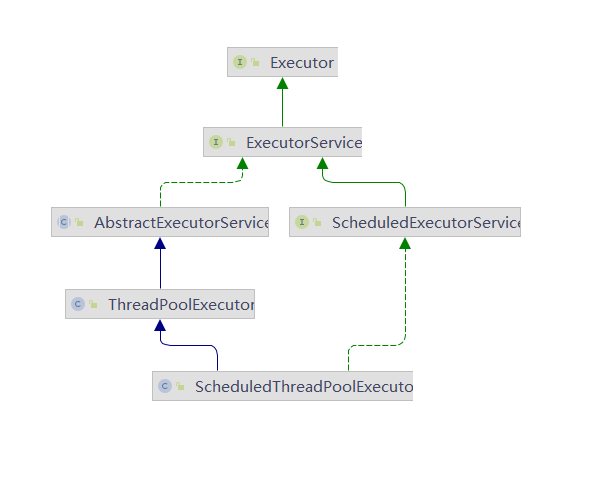线程池
定义和方法
线程池的工作时控制运行的线程数量,处理过程中将任务放入队列,然后在线程创建后启动这些任务,如果线程数量超过了最大数量,超出数量的线程排队等候,等待其他线程执行完成,再从队列中取出任务来执行。
特点:
线程复用,控制最大并发数,管理线程。
好处:
- 降低资源消耗。通过重复利用已创建的线程来降低线程创建和销毁造成的消耗。
- 提升响应速度。当任务到达时,任务不需要等待线程创建就能立即执行
- 提高线程的可管理性。当线程时稀缺资源,如果无限制的创建,不仅会消耗系统资源,还会降低系统的稳定性,使用线程池可以进行统一的分配、调优和监控。
简单的架构图:

我们使用的其实就是ThreadPoolExecutor.
阿里巴巴开发规范手册:
【强制】线程池不允许使用 Executors 去创建,而是通过 ThreadPoolExecutor 的方式,这样的处理方式让写的同学更加明确线程池的运行规则,规避资源耗尽的风险。
说明:Executors 返回的线程池对象的弊端如下:
1)FixedThreadPool 和 SingleThreadPool:
允许的请求队列长度为 Integer.MAX_VALUE,可能会堆积大量的请求,从而导致 OOM。
2)CachedThreadPool:
允许的创建线程数量为 Integer.MAX_VALUE,可能会创建大量的线程,从而导致 OOM。
首先使用工具类(Executors)来创建线程池:
FixedThreadPool被称为可重用固定线程数的线程池,执行长期任务性能好,创建一个线程池,一池有N个固定的线程,有固定的线程数的线程池。
public class demo1 {
public static void main(String[] args) {
//使用Executors工具类来创建newFixedThreadPool线程池
ExecutorService executor = Executors.newFixedThreadPool(3);
try{
for (int i = 0; i < 10; i++) {
executor.execute(()->{
System.out.println(Thread.currentThread().getName()+"任务执行");
});
}
} finally {
executor.shutdown();
}
}
}
SingleThreadExecutor是使用单个worker线程的Executor,省去了创建线程和销毁线程时资源消耗。
public class demo1 {
public static void main(String[] args) {
ExecutorService executor = Executors.newSingleThreadExecutor();
try{
for (int i = 0; i < 10; i++) {
executor.execute(()->{
System.out.println(Thread.currentThread().getName()+"\t任务执行");
});
}
} finally {
executor.shutdown();
}
}
}
CachedThreadPool是一个会根据需要创建新线程的线程池。可扩容的线程池。
public class demo1 {
public static void main(String[] args) {
//使用Executors工具类来创建newFixedThreadPool线程池
//ExecutorService executor = Executors.newFixedThreadPool(3);
//一个线程池就一个线程
//ExecutorService executor = Executors.newSingleThreadExecutor();
ExecutorService executor = Executors.newCachedThreadPool();
try{
for (int i = 0; i < 10; i++) {
executor.execute(()->{
System.out.println(Thread.currentThread().getName()+"\t任务执行");
});
}
} finally {
executor.shutdown();
}
}
}
pool-1-thread-2 任务执行
pool-1-thread-1 任务执行
pool-1-thread-4 任务执行
pool-1-thread-3 任务执行
pool-1-thread-5 任务执行
pool-1-thread-6 任务执行
pool-1-thread-7 任务执行
pool-1-thread-8 任务执行
pool-1-thread-9 任务执行
pool-1-thread-10 任务执行
当设置延时操作来模仿耗时的代码时使用线程池的过程。
package com.JucPool;
import java.util.concurrent.Executor;
import java.util.concurrent.ExecutorService;
import java.util.concurrent.Executors;
import java.util.concurrent.TimeUnit;
/**
* 基础认识以及线程池的三大方法
*/
public class demo1 {
public static void main(String[] args) {
ExecutorService executor = Executors.newCachedThreadPool();
try{
for (int i = 0; i < 10; i++) {
//暂停几秒
try {
TimeUnit.SECONDS.sleep(1);
} catch (InterruptedException e) {
e.printStackTrace();
}
executor.execute(()->{
System.out.println(Thread.currentThread().getName()+"\t任务执行");
});
}
} finally {
executor.shutdown();
}
}
}
pool-1-thread-1 任务执行
pool-1-thread-1 任务执行
pool-1-thread-1 任务执行
pool-1-thread-1 任务执行
pool-1-thread-1 任务执行
pool-1-thread-1 任务执行
pool-1-thread-1 任务执行
pool-1-thread-1 任务执行
pool-1-thread-1 任务执行
pool-1-thread-1 任务执行
Process finished with exit code 0
这时就降为SingleThreadExecutor线程池。
简单源码分析
public static ExecutorService newFixedThreadPool(int nThreads) {
return new ThreadPoolExecutor(nThreads, nThreads,
0L, TimeUnit.MILLISECONDS,
new LinkedBlockingQueue<Runnable>());
}
public static ExecutorService newFixedThreadPool(int nThreads) {
return new ThreadPoolExecutor(nThreads, nThreads,
0L, TimeUnit.MILLISECONDS,
new LinkedBlockingQueue<Runnable>());
}
public static ExecutorService newCachedThreadPool() {
return new ThreadPoolExecutor(0, Integer.MAX_VALUE,
60L, TimeUnit.SECONDS,
new SynchronousQueue<Runnable>());
}
通过对比发现,底层都是通过ThreadPoolExecutor来实现,只是参数的不同,传递的参数与阻塞队列也有关系。
参数:(非常重要)
- ·corePool:线程池常驻核心线程池的大小。
- ·maximumPool:最大线程池的大小--线程池中能够容纳同时执行的最大线程数
- keepAliveTime:多余的空闲线程的存活时间,当前池中线程数超过了corePool时并且空闲时间到达keepAliveTime,多余的线程会被销毁直到只剩下corePool个线程为止
- unit – keepAliveTime参数的时间单位
- workQueue – 用于在执行任务之前保存任务的队列。 此队列将仅保存由execute方法提交的Runnable任务。
在ThreadPoolExecutor中还存在两个参数:
- ThreadFactory: 表示生成线程池中工作线程的线程工厂,用于创建线程,一般默认
- Handler:拒绝策略,表示当队列满了,并且工作的线程要超过最大线程池的大小,如何让拒绝请求执行的runnable的策略
上述是线程池中的七大参数总结,很重要,关于什么情况下走到拒绝策略,后面会分析线程池的执行流程。